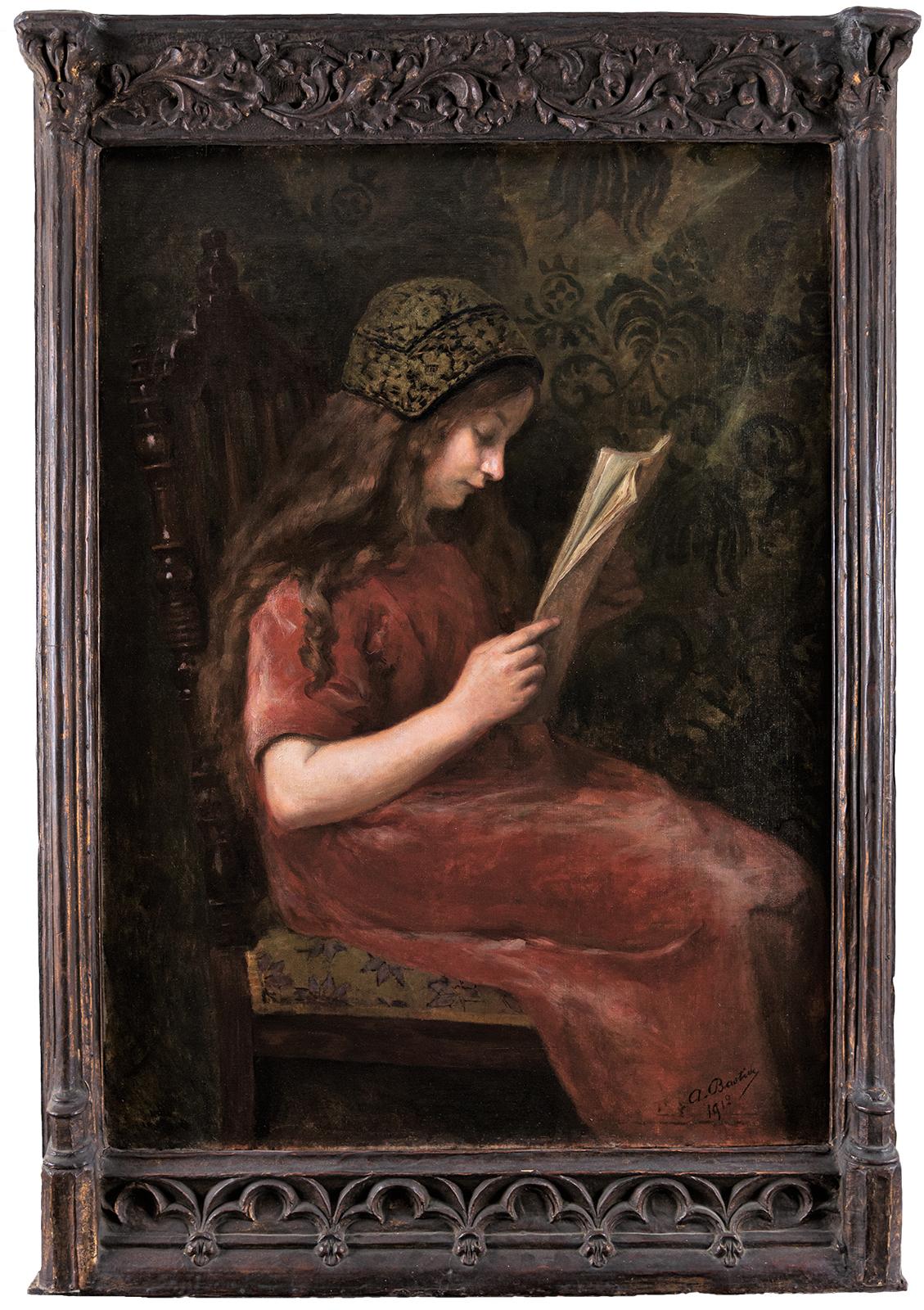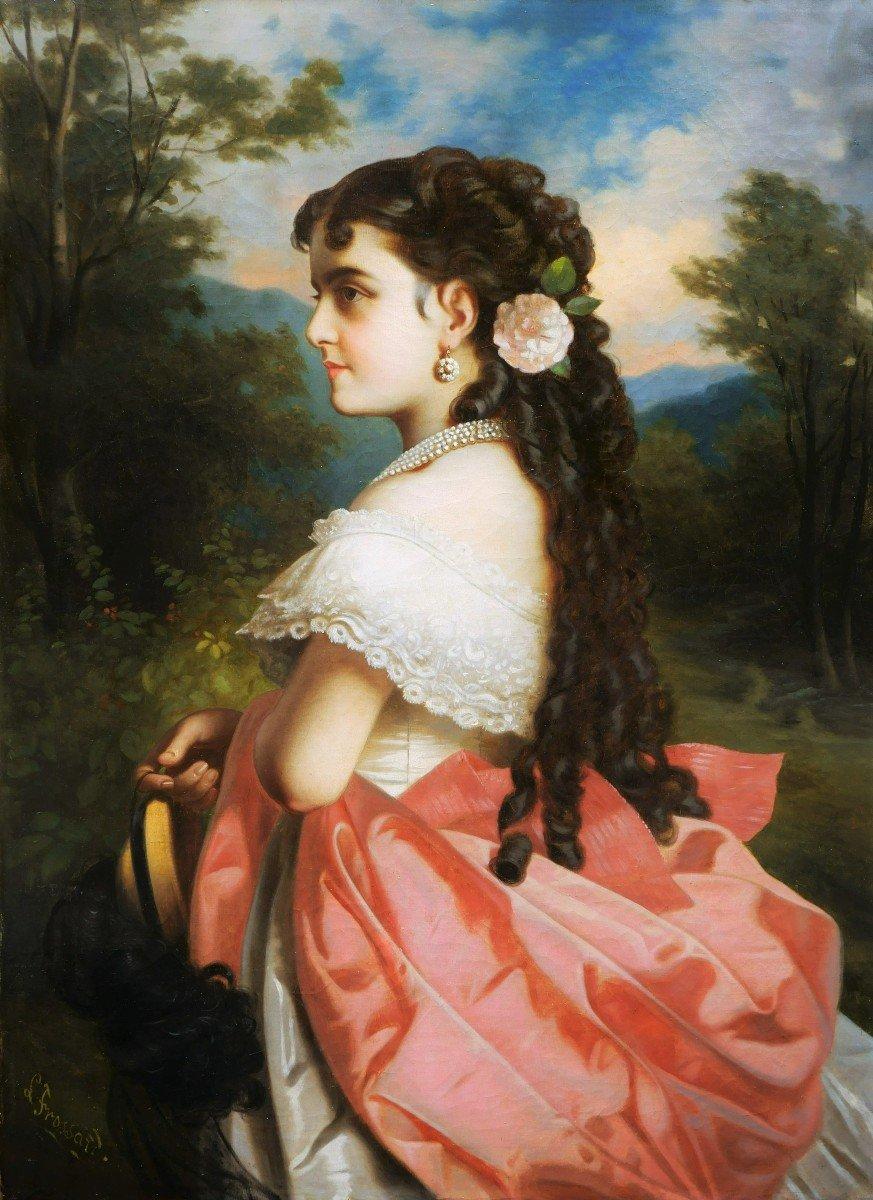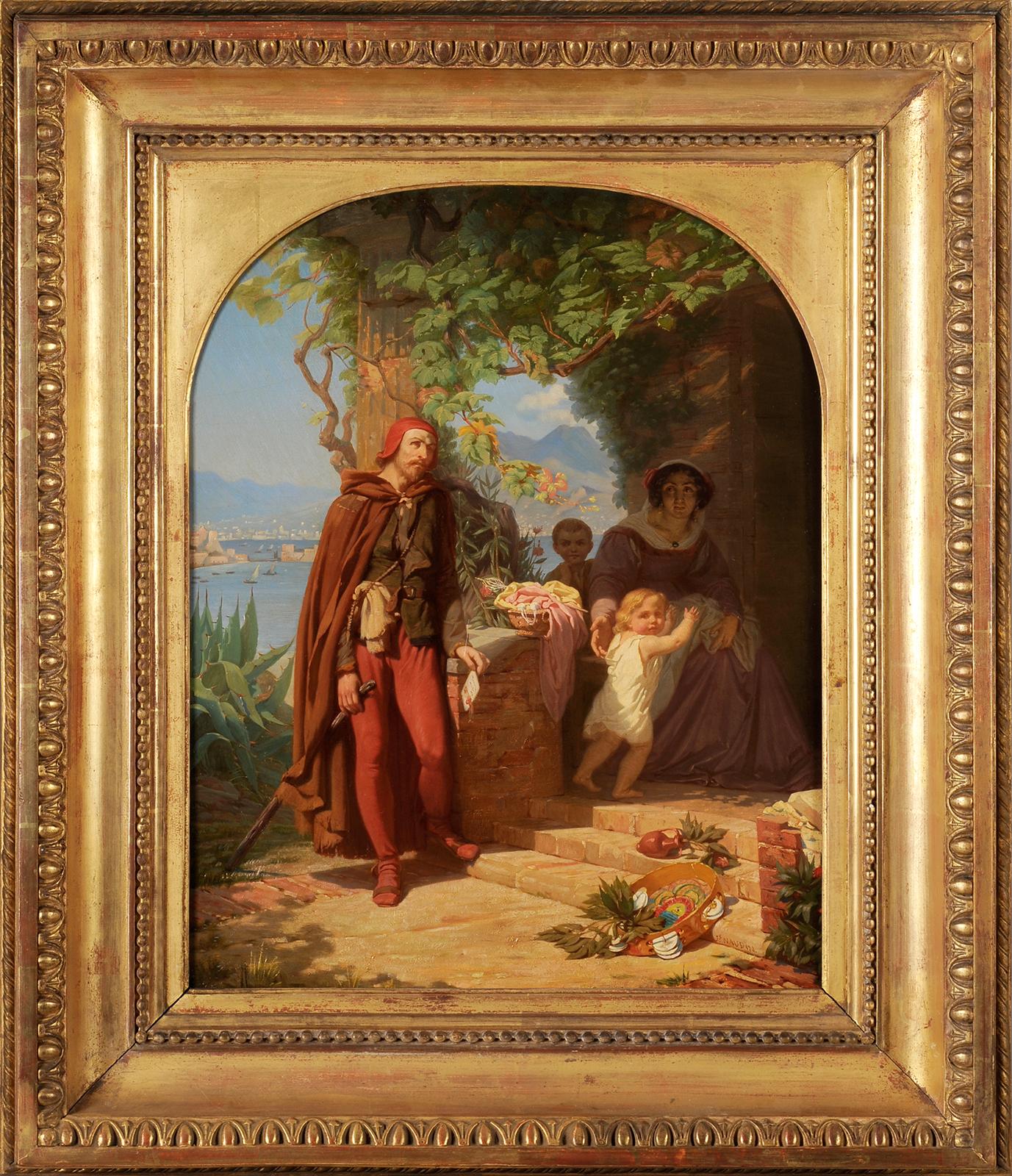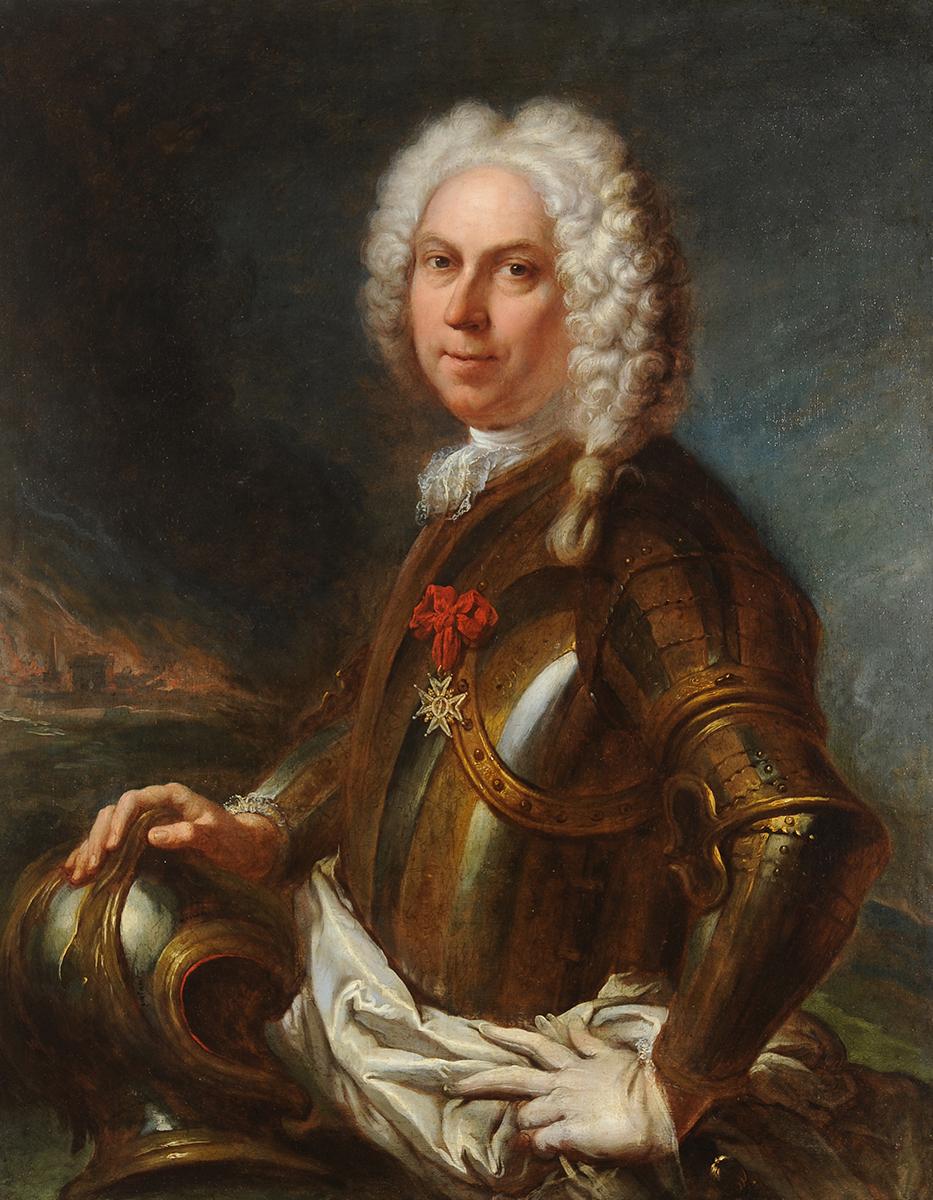Items Similar to Albert MANTELET (1858-1958) French School c1900 Oil Painting
Want more images or videos?
Request additional images or videos from the seller
1 of 12
Albert ManteletAlbert MANTELET (1858-1958) French School c1900 Oil Painting1900
1900
About the Item
Albert MANTELET (1858-1958)
A charming portrait of a young woman resplendent in her finest Sunday bonnet.
Albert Goguet Mantelet was considered to be one of the most accomplished pupils of Ernest Hébert and Heinrich Lehmann.
He painted fashionably attired women from French society. His style achieved
critical acclaim and he quickly became an established artist. Throughout his long career he specialised in genre painting.
His work can be found in the collections of Musees de Chateau Thierry and at Pontoise.
Condition
Heavy craquelure but, stable to the paint surface where it is thickest. Some overpainting to the sky top right.
- Creator:Albert Mantelet (1858 - 1958, French)
- Creation Year:1900
- Dimensions:Height: 15.3 in (38.87 cm)Width: 12.6 in (32.01 cm)
- Medium:
- Movement & Style:
- Period:
- Condition:
- Gallery Location:Holywell, GB
- Reference Number:
About the Seller
5.0
Vetted Seller
These experienced sellers undergo a comprehensive evaluation by our team of in-house experts.
Established in 1989
1stDibs seller since 2023
18 sales on 1stDibs
Typical response time: <1 hour
- ShippingRetrieving quote...Ships From: Holywell, United Kingdom
- Return PolicyA return for this item may be initiated within 14 days of delivery.
More From This SellerView All
- Attributed to Isidore-Alexandre-Augustin PILS (1815–1875)By Isidore Alexandre Augustin PilsLocated in Holywell, GBIsidore-Alexandre-Augustin PILS (1815–1875) A bewitching portrait of a young redheaded woman attributed to Isidore Pils. The same sitter appears in another of his other paintings,...Category
1890s French School Portrait Paintings
MaterialsOil
- Charles Joseph VAN LANDUYT (1854-1934) Malvina 1882Located in Holywell, GBA sensitive portrait of Malvina signed, dated 1882 and presented in its original magnificent heavy gilt frame. Van Landuyt was a Belgian School painter who studied at the Royal Aca...Category
1880s French School Portrait Paintings
MaterialsOil
- English School 18th Century Old Master Portrait Dated 1767 Oil PaintingLocated in Holywell, GBEnglish School 18th Century Old Master Portrait Dated 1767. An intriguing painting dating to the mid 18th century bearing a label verso which is indistinct, but appears to read, “Mr...Category
Mid-18th Century Old Masters Portrait Paintings
MaterialsOil
- Louise Jopling (1843-1933) Catalogue Raisonné PortraitBy Louise JoplingLocated in Holywell, GBLouise Jopling (1843-1933) Miss Enthoven A charming portrait of Miss Enthoven, thought to have been exhibited at the Dudley Gallery, London in the winter of 1878 under the title 'Portrait of Nelly - daughter of S Enthoven Esq.' Signed, dated, inscribed verso on the artist’s label and presented in its original kit-kat style frame.. Louise Jopling was one of the most highly regarded portrait artists of her time. Her sitters were the high society glitterati of the late Victorian era. Many examples of her work, for comparison, can be found on the artuk website. I am indebted to Dr Patricia de Montfort, Curator for Whistler Studies at the University of Glasgow for this research and the inclusion of this work in her catalogue raisonné. Credit Wikipedia Louise Jane Goode was born in Manchester, the fifth of the nine children of railway contractor Thomas Smith "T.S." Goode and his wife Frances. She married at seventeen to civil servant Francis "Frank" Romer. The Baroness de Rothschild, a connection of Romer's, encouraged Louise to pursue and develop her art. In the later 1860s, she studied in Paris with Charles Joshua Chaplin and Alfred Stevens, and first exhibited her work at the Salon. She entered works into the Royal Academy shows, 1870–73 (as Louise Romer). After Romer's 1872 death, she married Vanity Fair artist Joseph Middleton Jopling in 1874, who in 1888 was best man at Whistler's wedding to Beatrix Godwin. Of the children from her first marriage only one son, Percy Romer, survived childhood. She had another son, Lindsay Millais Jopling, by her second marriage; the child was named after his two godfathers Sir Coutts Lindsay, founder of the Grosvenor Gallery and John Everett Millais. She achieved fair success in her career: her painting Five O'Clock Tea was sold for £400 in 1874. Her Five Sisters of York was shown at the Philadelphia Exposition in 1876, and her The Modern Cinderella at the Paris Exposition of 1878. Yet she was not immune to the gender discrimination of her time: in 1883 she sought a portrait commission for 150 guineas, but lost it to Sir John Everett Millais, who was paid 1000 guineas for the same project. Jopling exhibited her work at the Palace of Fine Arts and The Woman's Building at the 1893 World's Columbian Exposition in Chicago, Illinois. She joined the Society of Women Artists (1880) and the Royal Society of Portrait Painters (1891); she became the first woman to be admitted to the Royal Society of British Artists (1901). During the years of her marriage with Jopling, she became the primary earner of the family. It is said that, "She found this responsibility weighty and stressful, necessitating constant production, regular sales and a continual search for commissions and clients. In 1879, despite her own illness and that of her son Percy, she produced eighteen works." Social life Jopling "painted portraits of titled sitters, wealthy financiers and actresses" and, to operate in this social milieu, she maintained a fashionable lifestyle, with a Chelsea studio at 28 Beaufort Street, designed by William Burges. She moved in a social circle that included James McNeill Whistler, Oscar Wilde, Kate Perugini (née Dickens) and Ellen Terry. Augustus Dubourg dedicated his 1892 play Angelica to her. In 1887 the society magazine The Lady’s World described her social circle, One year we have her portrait, magnificently sketched by Millais, adorning the walls of the Grosvenor; next season she figures as the heroine of a ‘society’ novel from the pen of a popular writer. One week we see her salon drawn by Mr. Du Maurier in Punch, with sketches from the life of herself and her friends; the week after she appears under another name as the heroine of one of those quasi-malicious town and country tales which amuse the readers of a society paper… Over the mantelpiece hangs the portrait, by her old friend Sir John Millais...Category
1870s Victorian Portrait Paintings
MaterialsOil
- Daniel De CONING (1660-1727) Portrait of a Cotswold GentlemanLocated in Holywell, GBA magnificent portrait of Henry Izod aged 67 in 1726, unsigned, but attributed verso to De Coning. Presented in a delightful frame probably the original. Th...Category
1720s Old Masters Portrait Paintings
MaterialsOil
- Antonin MERCIE (1845-1916) French Belle Époque PortraitBy Marius Jean Antonin MerciéLocated in Holywell, GBAntonin MERCIE (1845-1916) French Belle Époque Portrait A stylish portrait of a fashionable young woman dating to the Belle Époque period. Signe...Category
1890s Impressionist Portrait Paintings
MaterialsOil
You May Also Like
- Woman with Lobsters / "Femme et Homards"By Andre MinauxLocated in Berlin, MDAndre Minaux (French 1923 - 1986) "Femme et Homards" / Woman with Lobsters. Oil on canvas. Features a young woman holding one lobster while two others sit on a counter before her. ...Category
Mid-20th Century French School Portrait Paintings
MaterialsCotton Canvas, Oil
- Young girl readingLocated in BELEYMAS, FRAlice BASTIDE (Saint Mandé 1868 – Paris 1959) Portrait of a little girl reading Oil on canvas H. 100 cm; L. 72.5 cm Signed lower right and dated 1912 Daughter of a pastor from Gard and an English woman, Alice Bastide grew up in Paris. A pupil of the Jullian Academy, she began her apprenticeship under the guidance of Henri Royer and François Schommer. The development of his art is mainly oriented towards still lifes, without completely abandoning portraits and landscapes. Her other specialty for which she received numerous awards is miniatures. At the Salon of 1914 she received the Maxime David prize crowning the best piece while her finesse was already noticed by press critics from 1907. Coronation, in 1926 she received a gold medal at the Salon for her miniature Coquetterie. In 1896, the young woman married a man from Gard, Auguste Massebiaux, whose name she would occasionally bear. The latter, a lawyer at the Paris Court of Appeal, died in 1910. The couple had no children. At that time she was domiciled at 48 avenue d'Orléans (later named avenue du general Leclerc) in Paris where she lived until her death in 1959. Until the mid-1930s she continued to exhibit at the Salon des Artistes French with a manner very close to Impressionism, luminous and vigorous. In 1912, two years after the death of her husband, Alice Bastide was certainly still marked by the sadness of her mourning. The tones of our portrait of a little girl and the frame she puts together are dark and heavy. This child, wearing an embroidered bonnet, is bent over her book, her loose hair flowing over a red velvet indoor dress. This intimate portrait on a dark tapestry...Category
1910s French School Figurative Paintings
MaterialsOil, Canvas
- Portrait of singer Adelina Patti - L. Frossard - OperaLocated in BELEYMAS, FRL. FROSSARD (active in Vienna around 1870) Portrait of Adelina Patti (1843-1919) Oil on canvas H. 100.5 cm; L. 73.5 c Signed lower left If the artist maintains a certain discretion ...Category
1860s French School Figurative Paintings
MaterialsCanvas, Oil
- Jules Naudin (1817-c.1876) - Tasso arriving at his sister's house in SorrentoBy Attilio ManganaroLocated in BELEYMAS, FRJules Ambroise Francois NAUDIN (Paris 1817 – c.1876) Tasso arriving at his sister's house in Sorrento Oil on canvas H. 49 cm; L. 37.5 cm Signed lower right Exhibition: 1852, Paris Salon, under number 959 Related work: Engraving by Jean-Denis Nargeot in 1852 Bibliography: L’Illustration, April 24, 1852, engraved by Best, Hottelin and Regnier, after a drawing by Valentin) and reproduced p.260, cited p.262; La Mode: Political, Religious and Literary Review, 1852, quoted; Journal des Demoiselles...Category
1850s French School Figurative Paintings
MaterialsCanvas, Oil
- Model undressingLocated in BELEYMAS, FRJulius EXNER (Copenhagen, 1825 - Copenhagen, 1910) Model stripping Oil on canvas H. 122 cm; L. 74 cm Signed and dated 1842 lower right Exhibition: most likely Charlottenborg Salon of 1845, under number 110, titled Modelfigur, awarded with a silver medal Provenance: Emilio Fernando Bolt (c.1860 - 1944), acquired from the artist around 1900, then by descent Our painting was produced as part of the summer sessions organized between 1839 and 1850 by Christoffer Wilhelm Eckersberg (1783-1853), the master of Danish painting of the first half of the 19th century, in his private studio-apartment on the ground floor. floor at the Royal Academy of Fine Arts in Copenhagen. The master brought together a few students there between June and September, rented one or two models for the season, which were painted from different angles, the artists (including Eckersberg himself) sitting side by side. Eckersberg used to paint a fairly small version, the pupils of the larger formats. The work fits more generally into the legendary context of the research and reforms carried out by Eckersberg concerning the studies of nudes and in particular of female nudes, to make this exercise a genre of painting in its own right. Following his two-year stint in Jacques-Louis David's studio in Paris in 1811, Eckersberg had been made aware of work on the nude and in particular on live models, in natural light, while in Denmark the drawings were then only made from casts of antique models or other mannequins. In 1822, when he had been a professor there since 1818, it was he who had the Royal Academy of Copenhagen authorize the study of nudes, no longer in the evening by candlelight, but in natural light; from 1833, it was still he who allowed students to work on nude female models, even if the official authorization of the Academy did not take place until 1839. It was this same year that he instituted his summer sessions, on a private basis, to orient his painting and that of his students towards a new conception of the representation of models: even if the nude remains the real theme, it does not however, this is more than just an academic exercise. The subject is placed in a contemporary interior, with a rather sophisticated decor, and occupied with an intimate activity (it is this type of intimate vein that we will find later in Degas or Cassatt for example); thus in our painting, the young woman is supposed to take off her clothes to wash. The objective is that the viewer forgets that the master and his students are painting a model during a posing session, and that he instead has the impression of being alone with the model, but invisible, almost like a voyeur in spite of himself. Moreover, in these paintings, the model never looks towards the spectator, inducing a psychological distance with him, whereas model and artist are actually physically very close. On the other hand, it is not a question of idealized nudes either, even if Eckersberg, proof of his debt to the antique, chooses fairly classic models and poses. The sensuality is real and very present, with dreamy, even innocent, and timeless expressions (the models do not seem to have a defined age), suave and slow attitudes and movements, and especially with clothes that hide or reveal skillfully parts of the female body: upper buttocks, pronounced hips... Made by an artist under 20, our sensual painting is probably one of the most beautiful and spectacular produced by the students of Eckersberg during these summer sessions. With a perfect balance between the firmness of an ancient statue (it recalls the Venus de Milo) and the softness of the feminine forms, highlighted by a harmonious palette, it captures the attention with many details: the almost photographic folds white clothing...Category
1840s French School Nude Paintings
MaterialsCanvas, Oil
- Portrait of a man in armorLocated in BELEYMAS, FRAttributed to Jacques DUMONT aka DUMONT LE ROMAIN (Paris 1701 - 1781) Presumed portrait of Louis-Joseph de Formanoir (?-1732) Oil on canvas H. 91.5 cm; ...Category
1750s French School Figurative Paintings
MaterialsCanvas, Oil





